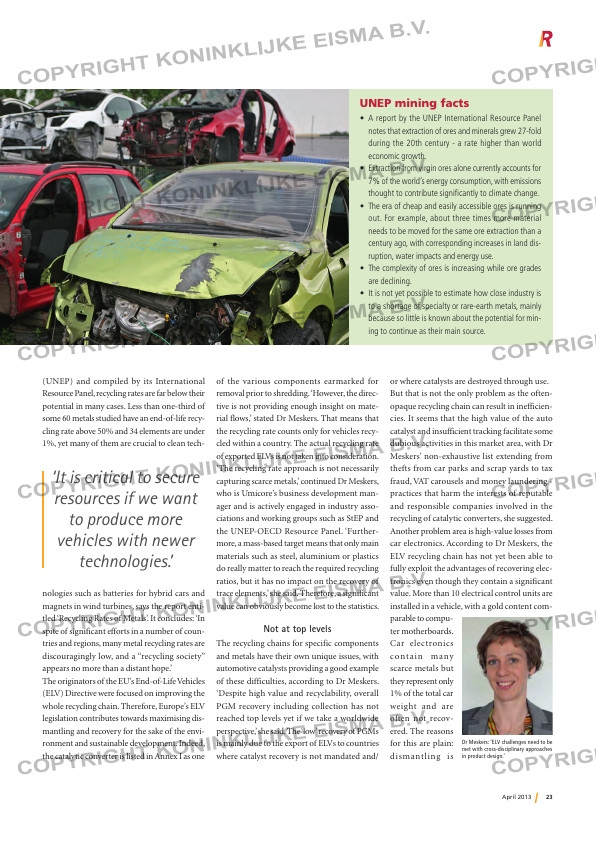Page 23 from: April 2013

23April 2013
(UNEP) and compiled by its International
Resource Panel, recycling rates are far below their
potential in many cases. Less than one-third of
some 60 metals studied have an end-of-life recy-
cling rate above 50% and 34 elements are under
1%, yet many of them are crucial to clean tech-
nologies such as batteries for hybrid cars and
magnets in wind turbines, says the report enti-
tled ‘Recycling Rates of Metals’. It concludes: ‘In
spite of significant efforts in a number of coun-
tries and regions, many metal recycling rates are
discouragingly low, and a “recycling society”
appears no more than a distant hope.’
The originators of the EU’s End-of-Life Vehicles
(ELV) Directive were focused on improving the
whole recycling chain. Therefore, Europe’s ELV
legislation contributes towards maximising dis-
mantling and recovery for the sake of the envi-
ronment and sustainable development. Indeed,
the catalytic converter is listed in Annex I as one
of the various components earmarked for
removal prior to shredding. ‘However, the direc-
tive is not providing enough insight on mate-
rial flows,’ stated Dr Meskers. That means that
the recycling rate counts only for vehicles recy-
cled within a country. The actual recycling rate
of exported ELVs is not taken into consideration.
‘The recycling rate approach is not necessarily
capturing scarce metals,’ continued Dr Meskers,
who is Umicore’s business development man-
ager and is actively engaged in industry asso-
ciations and working groups such as StEP and
the UNEP-OECD Resource Panel. ‘Further-
more, a mass-based target means that only main
materials such as steel, aluminium or plastics
do really matter to reach the required recycling
ratios, but it has no impact on the recovery of
trace elements,’ she said. Therefore, a significant
value can obviously become lost to the statistics.
Not at top levels
The recycling chains for specific components
and metals have their own unique issues, with
automotive catalysts providing a good example
of these difficulties, according to Dr Meskers.
‘Despite high value and recyclability, overall
PGM recovery including collection has not
reached top levels yet if we take a worldwide
perspective,’ she said. The ‘low’ recovery of PGMs
is mainly due to the export of ELVs to countries
where catalyst recovery is not mandated and/
or where catalysts are destroyed through use.
But that is not the only problem as the often-
opaque recycling chain can result in inefficien-
cies. It seems that the high value of the auto
catalyst and insufficient tracking facilitate some
dubious activities in this market area, with Dr
Meskers’ non-exhaustive list extending from
thefts from car parks and scrap yards to tax
fraud, VAT carousels and money laundering –
practices that harm the interests of reputable
and responsible companies involved in the
recycling of catalytic converters, she suggested.
Another problem area is high-value losses from
car electronics. According to Dr Meskers, the
ELV recycling chain has not yet been able to
fully exploit the advantages of recovering elec-
tronics even though they contain a significant
value. More than 10 electrical control units are
installed in a vehicle, with a gold content com-
parable to compu-
ter motherboards.
Car electronics
contain many
scarce metals but
they represent only
1% of the total car
weight and are
often not recov-
ered. The reasons
for this are plain:
dismantling is
Dr Meskers: ‘ELV challenges need to be
met with cross-disciplinary approaches
in product design.’
‘It is critical to secure
resources if we want
to produce more
vehicles with newer
technologies.’
UNEP mining facts
• A report by the UNEP International Resource Panel
notes that extraction of ores and minerals grew 27-fold
during the 20th century – a rate higher than world
economic growth.
• Extraction from virgin ores alone currently accounts for
7% of the world’s energy consumption, with emissions
thought to contribute signifi cantly to climate change.
• The era of cheap and easily accessible ores is running
out. For example, about three times more material
needs to be moved for the same ore extraction than a
century ago, with corresponding increases in land dis-
ruption, water impacts and energy use.
• The complexity of ores is increasing while ore grades
are declining.
• It is not yet possible to estimate how close industry is
to a shortage of specialty or rare-earth metals, mainly
because so little is known about the potential for min-
ing to continue as their main source.
RI-3_Automobile Recycling.indd 23 08-04-13 13:09



